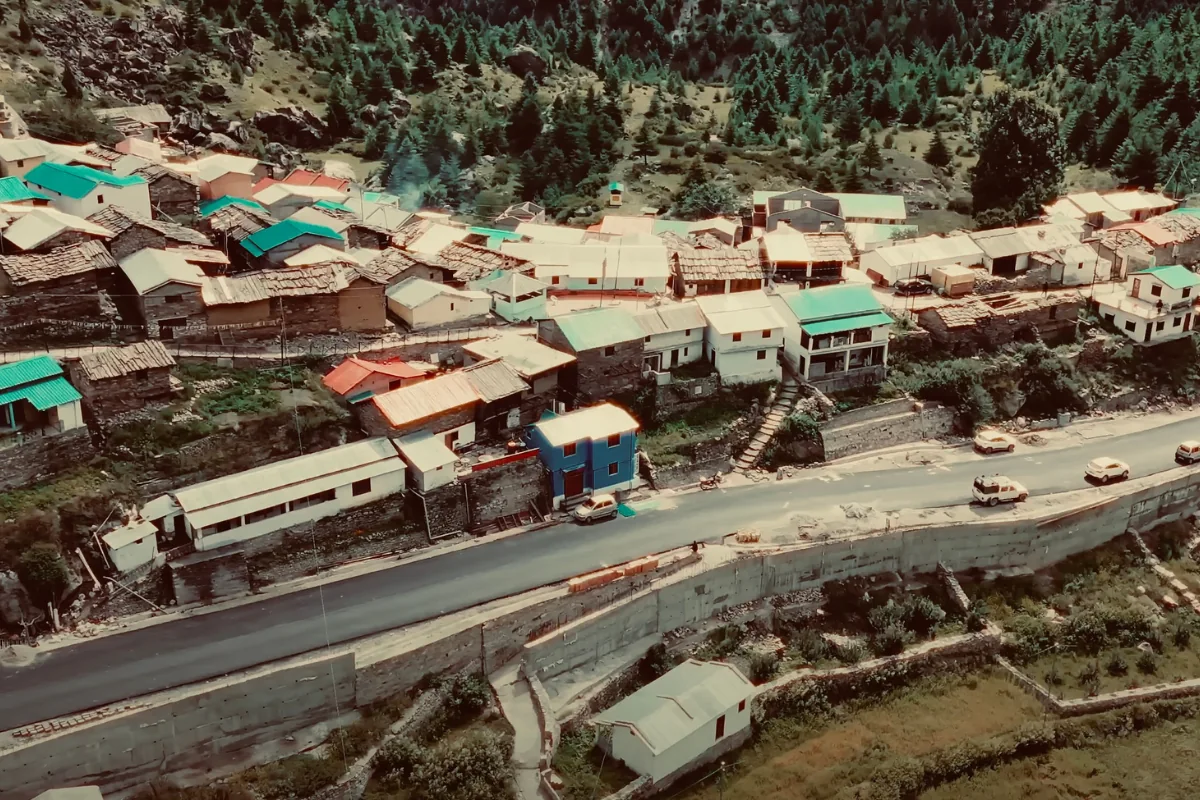

Sakshi
Writer
Updated On - Sep 29, 2025
20 min
Published On - Sep 29, 2025
Niti Valley Travel Guide 2025 – Gamshali Bugyal Trek, Villages, Route & Best Time
Hidden beyond Joshimath, cradled in folds of the Garhwal Himalayas, lies Niti Valley — a land of sacred peaks, timeless villages, alpine meadows, and untold stories. Few travelers make it this far, but those who do return with whispers of river songs, glaciers, and a culture that still bows to local deities and age old traditions.
Hidden beyond Joshimath, cradled in folds of the Garhwal Himalayas, lies Niti Valley — a land of sacred peaks, timeless villages, alpine meadows, and untold stories. Few travelers make it this far, but those who do return with whispers of river songs, glaciers, and a culture that still bows to local deities and age‑old traditions.
This guide brings you face to face with Gamshali Bugyal’s sweeping meadows, the Bhotiya villages of Gamshali & Niti, and the raw beauty of India’s frontier with Tibet. It’s a world where folklore meets nature, festivals meet snow‑covered peaks, and homestays replace luxury hotels. If adventure with soul is your style, Niti Valley waits with open arms.
Introduction
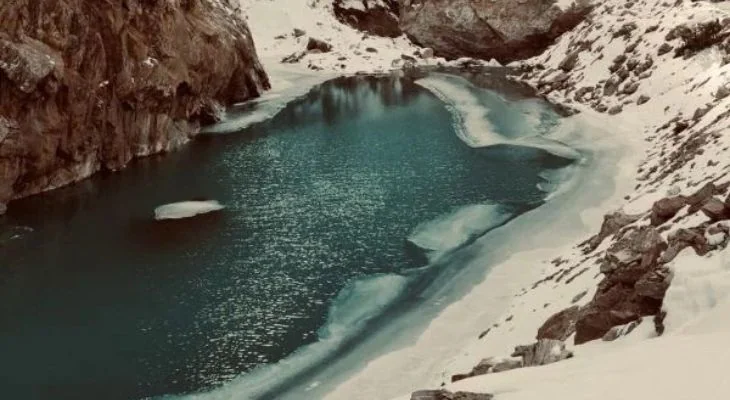
If the Himalayas were a storybook, Niti Valley would be one of its lost chapters — tucked quietly after the busy pilgrimage towns, lying at the edge of India where roads end and silence begins. Travelers often know of Badrinath, Auli, even the Valley of Flowers, but ask about Niti and you’ll see puzzled faces. That’s the charm — it is still Uttarakhand’s hidden frontier.
The valley stretches out from Joshimath towards the Indo‑Tibetan border, slowly shedding the crowd, shops, and concrete of pilgrim highways. What remains are serpentine mountain roads, the wild Dhauli Ganga river rushing alongside, and villages where life hasn’t bent entirely to modernity. Here, houses still wear carved wooden windows, wool is spun by hand, and entire festivals are dedicated to local gods like Fela Devta or Daan Devta.
What makes Niti Valley shine is not just the scenery, though you’ll get in scenery:
The Gamshali Bugyal trek gives you green pastures at over 11,000 ft with 360‑degree views of peaks like Dronagiri, Rishi Parvat, Lampak I & II, and Kakbhusandi.
Villages like Gamshali and Niti itself let you experience the daily rhythms of the Bhotiya community — semi‑nomadic herders who once traded across the Tibetan passes until 1962.
Rivers like the snow‑white Doodhganga merge into the mighty Dhauli Ganga, adding both beauty and sacredness to the journey.
But beyond landscapes, this valley tugs at your heart. Imagine this: you join villagers in a small bhandaara (community feast). Old songs narrating the Mahabharata echo across stone courtyards. A temple bell rings as clouds brush the treeline. Meanwhile, children scamper barefoot, and elders sip hot butter tea, narrating tales of how Lord Hanuman once lifted herbs from Dronagiri.
Niti Valley is also a place of contrasts: summers bring fields of potatoes, peas, rajma, and orchards of apples, while winters turn everything white and force families to migrate down to Chamoli or Dehradun. Staying in a rustic homestay, eating paahadi aloo, rajma, or the local delicacy suksa (sun‑dried meat), you don’t just visit Niti — you live a page of it.
In an age of fast travel and instant itineraries, Niti Valley teaches you to slow down. Roads may be winding, treks may be modest in distance but rich in soul, and life here follows rhythms of gods, rivers, and livestock. And that is what makes it special: it’s not just a destination, it’s an immersion into Himalayan living.
If your idea of travel is ticking off boxes, perhaps Niti is not for you. But if you believe in journeys that leave after‑tastes of smoky kitchens, roaring rivers, and timeless tales, this valley has been waiting quietly, just for you.
Getting There & Best Time To Visit
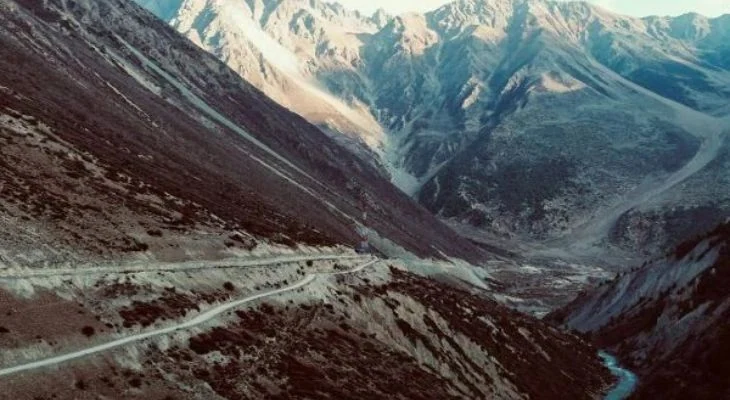
Getting There
Reaching Niti Valley is itself half the adventure. Think of it as a road trip that slowly peels away layers of the Himalayas.
Base Point: Rishikesh/Haridwar
Most travelers start from Rishikesh, the yoga capital, since it’s the gateway to the Garhwal Himalayas. From Delhi, it’s about 240 km — trains, buses, and taxis connect easily.Road Journey (Rishikesh → Joshimath → Niti Valley)
Distance: ~400 km total
Duration: 2 days recommended (though hardcore travelers push in one long day).Day 1: Rishikesh → Joshimath (280 km / 8–9 hrs):
The road runs along the Ganga, Bhagirathi, and finally Alaknanda, with iconic stops at Devprayag (confluence of Bhagirathi & Alaknanda → birth of the Ganga), Rudraprayag, and Karnaprayag. Smooth highways with regular dhabas and fuel pumps (no fuel worries until Joshimath).
Stay overnight at Joshimath or slightly before, at Helang, if you want less crowd.Day 2: Joshimath → Bampa → Gamshali → Niti (~100 km / 5–6 hrs):
After Joshimath, the roads narrow, the greenery fades, and raw cliffs rise. You pass sleepy settlements, apple orchards, and eventually enter true frontier terrain. Key point: Joshimath onward → NO Petrol Pump! Fill the tank at Joshimath itself.
You’ll also cross driving landmarks like Dronagiri peak viewpoint (linked to Ramayana’s Sanjeevani story) and Malari village checkpoint (ID proof submission required by ITBP).
Niti Valley trek route map in simple steps:
Rishikesh → Joshimath → Bampa → Gamshali → Bugyal trek (6 km one way) → Niti village (5 km further).
Road Conditions
Expect a mix: highways until Joshimath, then mountain roads with rough patches, landslide zones, and sharp hairpins. During monsoon (July–Aug), landslides often block routes. In autumn & summer, roads are motorable but narrow.
BizareXpedition™ Tip: Travel in a sturdy SUV or hire local taxi drivers — they know road behavior here. Self‑driving newbies? Think twice.
Best Time to Visit
Summer (April–June): The best time to visit the Niti Valley trek, with open meadows, wildflowers, and pleasant trekking weather (10–20°C).
Monsoon (July–Sept): Risky, with landslides and slippery routes. Not recommended unless you’re an experienced mountain traveler.
Autumn (Sept–Oct): Clear skies, sharp mountain views, harvest festivals in villages — the golden window.
Winter (Nov–March): Harsh, with heavy snow, blocked roads, and villages migrating downhill. Adventurers may love it, but homestays, food supplies, and routes shut down. Trekking amidst snow is both challenging and dangerous.
Niti Valley trek difficulty: Easy‑moderate. The Gamshali Bugyal trek is ~6 km one way, doable in a day, with gradual ascents. But high altitude (~11,000 ft) means slow, steady walking, and hydration is key.
Niti Valley trek duration: Most itineraries are 5 days (Rishikesh–Niti round trip). Add 7 days if combining with Badrinath/Valley of Flowers or longer treks.
In short: April–October is the sweet spot, Joshimath is your last “big town” hub, and beyond Malari you enter military‑guarded, silence‑filled Himalayan frontier. All it asks is a little patience, a strong vehicle, and an open heart.
Top Attractions & Experiences in Niti Valley

If Niti Valley is a poem, its verses are written with meadows, rivers, wooden houses, and mountain folklore. Here’s what you absolutely can’t miss.
Trekking in Niti Valley
Gamshali Bugyal Trek
This is the valley’s crown jewel — a 6 km trek (one way) starting from Gamshali village. Locals call it Pyar Bugyal, and rightly so.
Duration: 5–6 hours round-trip.
Altitude: Meadows open around 11,000–12,000 ft.
Difficulty: Easy‑moderate. Paths weave through fields of peas, potatoes, soybeans, and then twist into boulder passages and alpine grasslands.
The trek gifts you 360° views of Himalayan giants:
Dronagiri (7,066 m) — the legendary Sanjeevani pathal from Ramayana.
Lampak I & II — twin peaks nearly 6,000 m, glistening with glaciers.
Rishi Parvat (7,117 m) — towering in the backdrop.
Kakbhusandi peak, shrouded in local folklore.
By the midway, streams tumble beside you, shepherd camps dot the grass, and herds of sheep graze lazily. Villagers also point out Daan Devta’s shrine, believed to protect livestock across the season.
Niti Valley trek experience: Rather than strenuous endurance, it’s a slow‑motion walk through silence, snow peaks, and pastoral life.
BizareXpedition™ Safety Note: The bugyal is open pastureland. Weather swings quickly — carry woolens, water, and stick with the trail.
Route Extension: The Sagar Area
From the Bugyal top, trekkers can hike a couple more kilometres into an area once holding a lake, now dry due to glacial breaks. The solitude there is almost spooky but unforgettable.
Villages at the Edge of India
Gamshali Village
One of the largest Bhotiya settlements in the valley. Known for:
Carved houses made of stone & deodar beams.
Fela Devta temple, central to village belief.
Craftsmanship — women spin wool, older men carve wooden jangalas (balconies).
Gamshali also starred in Garhwali folk songs and the cult classic song Yake La shot here, giving it pop‑culture recognition.
Walk across lanes, and you’ll see tumbledown century‑old homes alongside new tin‑roof rebuilds. Almost every elder carries migration stories when the Tibet trade ceased in 1962 and families shifted seasonally to Dehradun or Chamoli.
Niti Valley trek accommodation: Homestays here are minimal but warm, run by families. Expect wooden rooms, daal‑chawal, rajma, or pahadi aloo for meals, priced around ₹800–1,000 a night.
Niti Village
Just 5 km ahead of Gamshali, perched at ~11,300 ft, this is India’s last inhabited village before the Tibet boundary. Its Doodhganga stream (literally “milk river”) truly flows milky white before merging into Dhauli Ganga.
Here, time slows. Stone courtyards, fluttering prayer flags, and kids darting across alleys greet you. While the village is modest in size, the idea of standing at India’s frontier, gazing at snow peaks with a silent border beyond, is priceless.
Niti Valley trek altitude: ~3,450 m at Niti village.
Malari & Bampa Villages
Malari (10,000+ ft): ITBP checkpoint where ID submission is mandatory. Wooden houses with flat stone roofs add to the picturesque vibe.
Bampa: Acts as a night halt before trekking out to Gamshali. Temples, rustic courtyards, and occasional village feasts make it a delight.
Temples & Local Deities
Niti isn’t just geography — it’s a valley of guardians. Almost every village bows to a Kul Devta (clan deity).
Fela Devta — strongly revered in Gamshali; believed to ride a divine horse imprinted on a rock. Worship includes fairs and community offerings.
Panch Nag (five serpent brothers) — guardians connected to local water sources; legends say they gifted springs to these parched mountains.
Panchanath Devta temple (Bampa): Major local shrine where villagers host community feasts (bhandaara).
During rituals, “Paswa” (mediums) go into trance, embodying the deity. For travelers, witnessing this is unforgettable — not as a tourist show, but as living faith.
Festivals & Living Culture
Pandav Leela: Seven‑day re‑enactment of the Mahabharata, where villagers themselves act as Pandavas, Arjun, and Draupadi. Traditional “masks” and bows are preserved for these occasions.
Lapa Festival (October): A grand affair where deities are invoked with music, dance, and offerings. Think of it as the valley’s cultural core.
Bari Tok Ritual: A unique archery‑linked custom tied to Fela Devta.
For trekkers, aligning your trip with August (Pandav Leela) or October (Lapa) means witnessing culture that cities have long forgotten.
Food & Local Delights
Food is simple, earthy, and seasonal:
Pahadi rajma with ghee — small‑grained, high‑flavor.
Alu‑suku — potatoes with dried meat pieces, enriching broth with smoky hints.
Siddu — steamed bread made of fafar (buckwheat).
Butter tea in winter.
You may also see suksa (preserved goat/sheep meat) hanging in courtyards for winter consumption, or taste pickles made of local greens.
Food isn’t commercial — it’s served at homestays or feasts. Carry dry snacks; shops are rare after Joshimath.
Rivers & Confluences
Dhauli Ganga: Lifeline of the valley, rushing from Tibetan glaciers to meet Alaknanda at Vishnuprayag (first of the Panch Prayags).
Doodhganga: Uniquely white‑flowing stream at Niti village.
Small alpine streams: Glide across Bugyal trails, perfect to refill bottles (use filters if possible).
Quick Snapshot of Experiences
Trek to meadows, see sheep and shepherds at Gamshali Bugyal.
Visit Niti — India’s last village.
Stay in rustic Bhotiya homestays.
Witness the Pandav Leela festival.
Spin wool with locals, hear migration sagas.
Stand at the Malari checkpoint, feel the frontier vibe.
Watch night skies — stars blaze like lanterns at this altitude.
BizareXpedition™ Tip: Carry Niti Valley trek route map offline — network is patchy after Malari. Also, evenings are cold even in May; a light down jacket is non‑negotiable
Culture & Food of Niti Valley
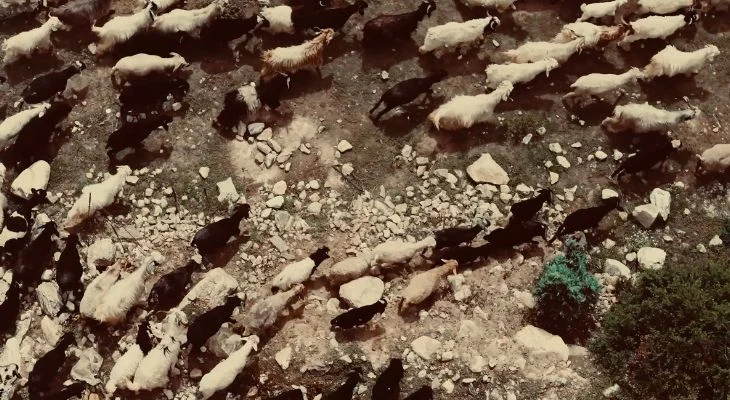
If the meadows and rivers are the body of Niti Valley, its soul lives in the villagers. Few places in India offer such an authentic peek into Himalayan frontier life.
The Bhotiya Community — Keepers of the Frontier
Every home in Gamshali, Niti, Malari, and Bampa belongs to the Bhotiya tribe, an Indo‑Tibetan group that once thrived on cross‑border trade with Tibet. Till 1962, families trekked with yak caravans over high passes, bringing back salt, wool, and borax. After the Indo‑China conflict, the trade ended. Life tilted:
Many families moved seasonally to Dehradun, Chamoli, and Rudraprayag for jobs or education.
Only a handful of elders stay in the high villages during summer; winters see complete migration downhill.
The stone‑and‑timber mansions with carved windows stand partly abandoned, ghosts of a wealthier era.
Step into a courtyard, though, and you may find women weaving wool, elders narrating Pandav Leela tales, or someone hand‑crafting incense sticks from juniper (juphar) shrubs.
Niti Valley trek history/significance: Beyond trekking trails, the valley is a living timeline of Himalayan trade and migration.
Homes & Handicrafts
Traditional Bhotiya homes deserve their own photo album:
Built of stone with deodar wood carvings (jangla balconies, ganesh doorframes).
Interiors lined with woollen rugs, low wooden pattis to sit on, and brass pots hanging from hooks.
Old houses may be 100+ years old, now patched with tin during modern repairs.
Handicrafts & Wool Work
Women still card and spin sheep wool into yarn, weaving sweaters, socks, carpets, and aasans (floor mats).
Wool cleaning is often done communally — separating coarse from fine strands in courtyards.
These crafts are not factory‑sold but handmade, mostly for family use, and sometimes offered to visitors as souvenirs.
Niti Valley trek essentials: A woollen pair of locally made socks or a cap is both practical and a memory to carry back.
Faith, Rituals & Festivals
Faith binds the valley like mortar. You’ll notice more small temples than shops. Life weaves around these deities:
Fela Devta: The horse‑riding protector god, worshipped in Gamshali, whose rock imprint “horse” marks his divine presence.
Panch Nag: Serpent deities believed to gift water springs, worshipped especially in Bampa.
Paswa Rituals: Mediums (men or women) who enter trance during festivals, becoming channels of gods.
Festivals add drama:
Pandav Leela: Villagers don masks, wield bows, and enact Mahabharata tales with trance‑like conviction. The astras (bows/swords) are stored in temples all year, only “awakened” during this festival.
Lapa Festival (October, Gamshali): Cheerful dances, processions, and animal feasts mark the transition before winter migration.
Niti Valley trek guide requirements: While trekking here is simple, locals often double as guides. Hiring them not only helps navigation but also earns you invitations to these local rituals.
Flavours of Niti Valley
Food in Niti Valley comes from fields and hearths, not markets. Expect no menus — homestays serve what they have.
Pahadi Aloo: Small, nutty potatoes cooked in a dozen variations.
Rajma‑Chawal: Thin mountain rajma with smoky ghee.
Suksa (Dried Meat): Sheep or goat meat dried in courtyards before winter. Cooked later with potatoes and black lentils — hearty and warming.
Siddu: Soft buns made from fermented buckwheat or wheat flour, often stuffed with jaggery or ground walnuts.
Butter Tea: A Tibetan influence, salty and perfect for high altitudes.
Apricots, walnuts, apples: Harvested from village orchards in summer.
Meals are basic but filling. Homemade thalis cost ₹100–150, making mountain travel affordable.
Seasonal Rhythm
The greatest cultural feature here is migration:
April → Families return to villages, sow potatoes/peas, repair homes, celebrate festivals.
Summer → Shepherds move flocks to Bugyals, women spin wool, orchards bloom.
October → Villagers celebrate Lapa, store dry meat & crops, then descend to the plains before snow seals the valley.
Winter → Villages empty. Silent, windswept, only ITBP patrols.
Niti Valley trek vs Valley of Flowers: While Valley of Flowers is lush and seasonal (monsoon blooms), Niti is cultural and rugged — a blend of trek plus lived history.
Quick Takeaways
Culture: Bhotiya, semi‑nomadic, god‑centred, Tibetan‑influenced.
Festivals: Pandav Leela (Aug), Lapa (Oct).
Food: Pahadi potatoes, rajma, sukha meat, siddu, butter tea.
Crafts: Wool spinning, wood carving, and deodar houses.
Stay: Rustic homestays; no luxury hotels.
BizareXpedition™ Tip: Carry dry snacks, tea bags, ORS, as shops are rare. Also, bring small gifts (notebooks, chocolates) — kids adore them, and it’s a great icebreaker.
Practical Guide to Niti Valley

This section is your ready reckoner — so even if you skipped the stories, you can still plan the trip with just these notes.
How to Reach
Base City: Rishikesh (well connected by train, bus, and cab from Delhi).
Route Map:
Rishikesh → Devprayag → Rudraprayag → Karnaprayag → Chamoli → Joshimath → Malari → Bampa → Gamshali → Niti.Total Distance: ~400 km (Rishikesh–Niti village).
Trek Starting Point: Gamshali village (for Bugyal).
Niti Valley trek distance: ~6 km to Gamshali Bugyal (one way).
Niti Valley trek duration: ~5–6 hours doable in one day; whole trip ideally 5 days from Rishikesh.
Best Itineraries
3‑Day Itinerary (Quick Escape)
Day 1: Rishikesh → Joshimath (280 km / 8 hrs). Overnight stay.
Day 2: Joshimath → Bampa → Gamshali → Trek Gamshali Bugyal. Return & stay in a homestay.
Day 3: Early visit to Niti village, then return towards Rishikesh.
5‑Day Itinerary (Ideal)
Day 1: Rishikesh → Joshimath (overnight).
Day 2: Joshimath → Malari checkpoint → Bampa stay.
Day 3: Trek to Gamshali Bugyal. Overnight at Gamshali homestay.
Day 4: Visit Niti village + Timber Sen Mahadev Cave (Amarnath‑like Shivling in winters).
Day 5: Return to Joshimath → Rishikesh.
Extension Options
Add Badrinath (just 50 km from Joshimath).
Combine with Valley of Flowers/Hemkund Sahib for a 7‑day “Garhwal Explorer”.
Where to Stay
Joshimath: Hotels, Cottages and HomeStays.( Hotel-Satopanth Auli, Cottage – Blackberry Cottages, Home stay - )
Bampa / Gamshali / Niti: Only rustic homestays — stone or tin houses, 2–3 bedrooms, basic meals.
Camping: Allowed in Bugyals (carry your own tent; water streams present).
Niti Valley trek accommodation: Homestays are best for cultural immersion. Luxury hotels? None.
Meals
Homestays serve: Daal‑Chawal, Rajma, Pahadi Aloo, Pickles, sometimes Chicken or Suksa.
Snacks: Carry from Joshimath; limited shops after Malari.
Cost: ₹100–150 per thali.
Permits & Rules
Earlier, special permits were needed, but now Indian citizens can enter without permits.
Foreigners are not allowed beyond Malari (border zone).
ID Submission: Mandatory at the ITBP checkpoint in Malari; submit Aadhar/ID, collect it while exiting.
A trekking guide is not mandatory for Bugyal, but strongly recommended.
Niti Valley trek permit rules: Indians → carry photo ID; foreigners → need defense clearance, usually not allowed.
Essentials & Packing List
Clothes: Layers, down jacket (nights ~5°C even in May), rain gear.
Shoes: Sturdy trekking boots.
Backpack Must‑carry:
o Water bottle (streams available en route).
o Sunscreen, cap & sunglasses (UV high at altitude).
o Energy snacks (dry fruits/chocolate).
o Torch/headlamp.
o Camera + offline maps (no network after Malari).
o Small personal medical kit (Diamox for altitude, ORS, painkillers).
Niti Valley trek essentials: Woollen socks from locals, rain gear, ID cards, reusable bottles, power bank (no charging after Joshimath).
| Category | Per Person / Day | Includes |
|---|---|---|
| Budget | ₹3000-4000 | Homestay + 2 meals + jeep share |
| Mid range | ₹4,000–6000 | Better hotels in Joshimath, private cab, homestay in valley |
| Luxury | ₹6,000+ | Difficult here! Only possible with full private SUV, upmarket Joshimath hotel stay |
Budget Snapshot
Our trip (3 ppl / 5 days): ~₹12,000 per head, including petrol, homestays, and food.
Safety & Do’s & Don’ts
Do’s:
Carry cash (no ATMs after Joshimath).
Respect local customs (remove shoes in temples, ask before photographing).
Walk slowly on trek → altitude 11,000 ft can hit.
Hire local guides — great for stories, culture, and routes.
Don’ts:
No loud music or alcohol in bugyals or sacred places.
Don’t pick wild herbs/flowers without asking (many are considered sacred).
Do not trek solo in winter — snow bridges and isolation are real risks.
Niti Valley trek safety tips: Check the weather before starting, never push during landslides, keep the ITBP check‑post timings in mind (evening crossings discouraged
Road Conditions
Till Joshimath: Good highways, plenty of fuel, and eateries.
Joshimath → Malari → Bampa → Gamshali/Niti: Narrow roads, prone to landslides in monsoon.
SUV recommended. Hatchbacks can go, but carefully.
Expect 20–25 km/hr average post‑Joshimath.
Niti Valley trek road conditions: Usable but rugged — travel time is always double that of Google Maps.
Mini Comparison
Niti Valley Trek vs Valley of Flowers:
Niti = cultural, rugged, mix of villages + meadows + frontier feel.
Valley of Flowers = floral paradise, UNESCO site, famed globally.
Niti’s advantage = empty trails & authenticity.
Quick Practical Highlights
Trek Distance: 6 km (Gamshali Bugyal).
Trek Duration: 1 day (trekking), whole trip 5 days round-trip.
Difficulty: Easy‑moderate.
Altitude: ~11,000–11,300 ft.
Accommodation: Homestays, camping.
Food: Local thalis, rajma, aloo, siddu, butter tea.
Permit Rules: Indians have free entry with ID, foreigners are restricted at Malari.
Road Conditions: Good till Joshimath, rugged after.
BizareXpedition™ Tip: Always check mobile connectivity: Only Jio works patchily after Bampa. Offline maps + printed route are lifesavers.
Conclusion — Why Niti Valley Stays With You
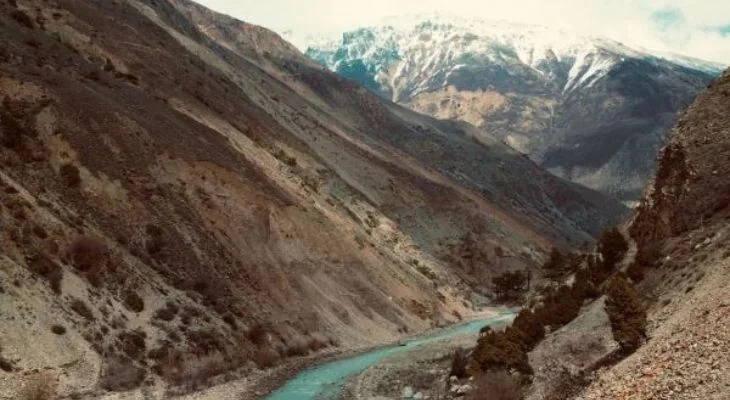
Travelers often chase destinations for their popularity — names like Valley of Flowers, Hemkund Sahib, or Badrinath fill most Uttarakhand itineraries. But Niti Valley? It whispers, it doesn’t shout. That’s why it hits deeper.
Here, the memories you carry aren’t just of landscapes but of moments stitched together:
Sitting in a Gamshali courtyard as elders spin wool and narrate how they once crossed into Tibet with yak caravans.
Watching the Doodhganga gush down like liquid milk against the black rock.
Sharing a thali with rajma and pahadi aloo that tastes more satisfying than any five‑star buffet.
Trekking over soft meadows where sheep graze while the Himalayan giants glare down silently.
Joining villagers at a Pandav Leela evening — seeing faith, theatre, and community blur in candlelight.
Niti Valley is not an instant‑gratification place. It teaches patience — through winding roads, limited comforts, and quiet homestays. But that is its gift. For those willing to step away from tourist crowds, the valley gives you an unfiltered Himalayan experience.
It’s also about contrast — one moment you’re in pulsating Joshimath town, the next you’re in a hamlet where the temple bell is louder than the road traffic. One day you’re hiking Bugyals in sunlit calm, the next you’re wrapped in mist watching flocks vanish in cloud.
So, why visit Niti Valley? Not because it’s comfortable. Not because it’s famous. But because it’s real. A slice of frontier life where nature and culture still outweigh concrete.
When you return, perhaps you won’t recall exact trek distances or altitudes. But you’ll remember the smell of juniper incense, the crisp crack of wool being carded, the 360° mountain amphitheatre at Bugyal top, and the smile of a villager offering butter tea by a hearthfire.
And those memories will follow you much longer than any map, permit, or travel fee.
In the end, Niti Valley is less a trip — more a timeless story you become part of.